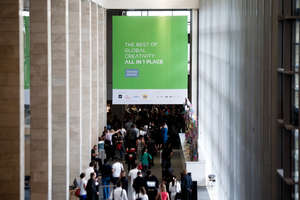
South Africa's Cape Town is a city of architectural extremes, from the futuristic, 30,000-square-foot houses of the super-rich in Clifton to the corrugated metal shacks of Langa township. And it is a city of physical barriers. Prominently advertised in the Cape Times are hammer-proof, roll-down shutters that are “extremely difficult to break without the use of power tools.”
 |
| Photo courtesy Design Indaba Design Indaba attendees at the Cape Town International Convention Center. |
It was a different story inside the Cape Town International Convention Centre from February 27 through March 3, where, during the annual conference known as Design Indaba, there are no barriers, professional or otherwise. With Michael Beirut, the New York-based graphic designer and polymath, setting the tone as genial host and gentle interlocutor, design world luminaries took to the brightly colored stage to present projects that in many cases erase lines between disciplines.
David Adjaye spoke movingly about opening his first African office, in Accra, 3,000 miles to the north. But there were few other Africans (and few other architects) on the program—both subjects of complaints aired during breaks at the Convention Center, itself the work of local architects Anya Van Der Merwe and Macio Miszewski. Still, much of the work presented by American and European designers was architectural in scale. Paula Scher, a prominent New York-based graphic designer, showed a series of schools whose walls she has covered with motivational phrases. “It’s become an industry for me,” she said, of the so-called super-graphics, which in some cases compensate for a lack of architectural detailing. After all, while value engineering often quashes architectural ambition, “percent for art” programs provide secure funding for surface decoration.
Asif Khan, from London, presented an installation in which soap suds mixed with helium were released into a room, forming indoor cumuli. He wondered why architecture couldn’t be always be “as light and intuitive as a cloud.” The Basque designer Martí Guixé proffered conceptual spaces, like a kitchen-less restaurant where diners order off take-out menus and wait for their food to be delivered. The restaurant, Guixé said, is like Google—an organizer of content but not a creator. (Another of his projects involves vaporizing gin and tonics, so partygoers can "drink" without having to carry glasses.)Daan Roosegaarde of Rotterdam showed environments in which LED “gardens” respond to the motions and, perhaps, the emotions, of passersby. Reality, he said, “is not stable anymore; it’s a reflection of who we are.”
All of these projects made for good Design Indaba-style talks (a longer, breezier version of a TED talk). But are the designers, with their architecturally-inflected work, architects' allies? Some of their temporary installations, meant to amuse, provoke, and then disappear, avoid the hard work of architecture, which is about creating durable environments. But the designers may have something to teach architects about making buildings fun.
Design Indaba is dedicated to the idea that design can solve the problems of the world, if we could all just work together. If the approach can seem a bit naive, it's a reminder that a world of cooperation is better than a world that requires hammer-proof shutters.

Post a comment to this article
Report Abusive Comment